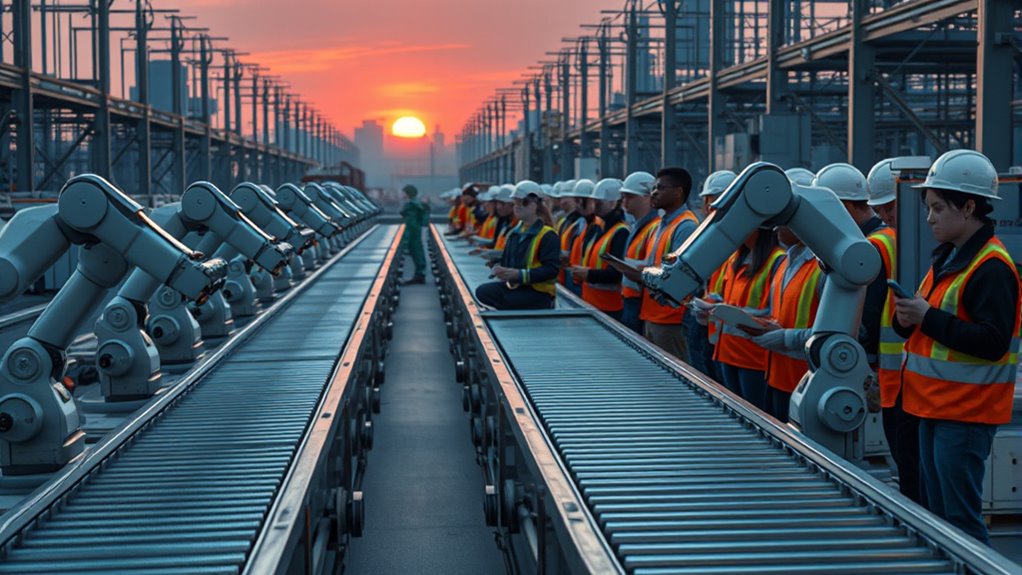History shows that new jobs created by technology often lag behind or don’t fully replace those lost to automation. While industries like healthcare, green energy, and tech are creating opportunities, many roles, especially white-collar and manual jobs, are declining or changing rapidly. The shift can lead to skill gaps and uncertainty about long-term stability. If you want to understand whether jobs will ever fully offset tech-driven losses, explore what’s really happening behind the headlines.
Key Takeaways
- Approximately 14% of current jobs may be displaced by AI and automation by 2030, with new roles emerging in tech and green sectors.
- Job creation often lags behind displacement, meaning some workers face persistent unemployment or underemployment.
- Skills gaps and slow reskilling efforts can prevent displaced workers from transitioning into new roles.
- Certain sectors, especially white-collar professions, may experience more job losses than gains despite overall economic growth.
- Future job growth depends on proactive adaptation, including upskilling, reskilling, and the development of new industries like sustainability and healthcare.
The Current Landscape of Job Displacement and Creation

The current landscape of employment is shifting rapidly as technological advancements and economic changes reshape the job market. You’ll see around 92 million jobs expected to become obsolete by 2030, mainly in clerical, secretarial, and manual roles. Manufacturing could lose two million workers to automation by 2025, and AI is set to transform 86% of businesses. Despite displacement, new jobs will emerge, accounting for about 14% of today’s total employment—roughly 170 million positions—between 2025 and 2030. Sectors like healthcare, education, green energy, and the care economy are expected to grow crucially. Meanwhile, industries such as agriculture, manufacturing, delivery, and construction will see high demand. Adaptability, digital skills, and green expertise will be essential as the workforce navigates these shifting dynamics. Technological change continues to drive the creation of new roles, even as traditional jobs decline. Additionally, understanding Retirement Planning strategies, such as leveraging IRAs for future security, can help workers prepare for economic transitions. It is also important to recognize how job displacement impacts various communities and the importance of reskilling initiatives to mitigate negative effects, especially as automation impacts the availability of traditional employment options. Recognizing the role of innovation in job creation can provide a more comprehensive understanding of how technological progress influences employment opportunities.
How Automation and AI Are Reshaping the Workforce

Automation and AI are changing the way you work by automating routine tasks and shifting the skills needed for success. As a result, roles now require more critical thinking, creativity, and emotional intelligence. To stay relevant, you’ll need to reskill and adapt to these evolving job demands. AI’s potential to automate cognitive functions such as reasoning and decision-making is transforming industries and redefining employment opportunities across the board. Understanding the essential oils for skills development can help professionals enhance focus and adaptability in this rapidly changing environment. Incorporating creative practice into your routine can foster innovative thinking and problem-solving abilities, making you more adaptable to technological shifts. Staying informed about vetted tools and strategies is crucial for navigating this new landscape effectively. Additionally, awareness of local store hours can be beneficial for planning your shopping trips efficiently amidst changing retail hours. Developing a strong foundation in home improvement skills can also empower individuals to adapt to new roles that involve maintenance and renovation tasks within their communities.
Automation’s Evolving Impact
Automation boosts productivity but displaces many workers. Managers may see 69% of tasks fully automated soon. Wage declines of up to 70% since 1980 highlight economic shifts. About 14% of workers already lost jobs to AI and automation. As technology advances, cost of living adjustments and adaptations are increasingly important for maintaining a comfortable and functional lifestyle. Understanding philosophical insights on existence and ethics can also help in navigating the moral and societal implications of these technological changes.
Skill Shifts in Job Market
With AI increasingly integrated into workplaces, you must adapt your skill sets to stay relevant. The demand for AI-related skills like machine learning, frameworks such as TensorFlow and PyTorch, is rising sharply. Data interpretation and visualization skills, using tools like Power BI and Tableau, are also becoming essential. Cloud infrastructure expertise in AWS and Azure is in high demand as companies migrate online. Basic cybersecurity skills are increasingly essential due to the reliance on digital systems. Additionally, prompt engineering and generative AI are expanding fields, creating new opportunities. Employers now focus more on critical thinking and technical expertise, shifting away from repetitive tasks. Continuous learning and reskilling are indispensable, as AI transforms industries and opens fresh career paths in data analysis, AI engineering, and cybersecurity. Skills in Rise are supported by real-time labor market data showing consistent growth in these areas. Developing adaptability is crucial for navigating these ongoing technological shifts and maintaining employability. Moreover, staying updated with evolving automation trends helps professionals anticipate future changes and remain competitive in the job market. Recognizing how prophetic dreams historically reflect subconscious processing can also inspire innovative thinking about future technological developments. Staying aware of technological change enables workers to better prepare for and leverage these shifts to their advantage.
The Disparity Between Job Growth and Loss Across Industries

Despite widespread layoffs in the tech sector, other industries are still adding jobs, creating a clear disparity in the overall job market. While tech companies cut thousands of positions, sectors like manufacturing and data centers continue to hire, balancing the employment landscape. Automation is reshaping roles, automating routine tasks but also opening new opportunities. Globally, regions like India see growth in IT and investment, contrasting with U.S. tech layoffs. Economic pressures and market demands drive restructuring in tech firms, influencing regional disparities.
- Manufacturing and data centers keep hiring, offsetting tech losses
- Automation replaces some jobs but creates new roles in AI and infrastructure
- International shifts show growth in regions like India
- Youth unemployment remains high despite overall job trends
Skill Gaps and the Challenge of Transitioning Workers

The growing skills gap presents a significant hurdle for workers trying to adapt to a rapidly changing job market. You face challenges in transitioning roles due to the need for new skills, often requiring substantial investment in training. Employers report that 74% struggle to find candidates with the right skills, and the IT sector faces a projected revenue loss of $5.5 trillion by 2026. To address this, many are turning to skills-based hiring, with 95% adopting this approach. Reskilling can boost retention—83% of employees are more likely to stay longer. However, more than half of employees will need upskilling or reskilling by 2025 to keep pace with technological shifts.
| Skill Gap Impact | Key Statistic |
|---|---|
| Workforce Shortage | $8.5 trillion cost by 2030 |
| Employee Upskilling | >50% need reskilling by 2025 |
| Employer Strategies | 81% use skills-based hiring |
The White-Collar Recession: Myths and Realities

Many people believe white-collar jobs will always grow alongside the economy, but recent data shows otherwise. As AI and automation accelerate, certain professional roles are disappearing faster than new ones are created. This challenges the myth that economic growth guarantees continuous job expansion in white-collar sectors.
Displacing White-Collar Professions
As AI-driven efficiency accelerates, white-collar jobs face unprecedented erosion, challenging the belief that new roles will always emerge to replace those lost. Despite rising GDP and profits, hiring for professional roles has slowed considerably. Advanced AI tools like ChatGPT are automating tasks in finance, tech, and legal sectors, putting many jobs at risk. The decline in job openings for entry-level analysts and junior lawyers signals a shift in employment patterns, with automation replacing human labor. Furthermore, 40% of employers plan workforce reductions where AI can step in. This rapid displacement impacts social mobility and talent diversity, especially as remaining hires may accept lower wages to adapt. The era of quiet erosion is over; AI’s speed now reshapes white-collar work more abruptly than ever.
- AI tools are replacing tasks in finance, tech, and legal fields
- Job openings for entry-level roles are declining sharply
- Employers plan workforce reductions where automation fits
- Social mobility and diversity face new challenges
Myth of Continuous Growth
Despite widespread expectations of continuous growth in white-collar employment, recent data reveal a stark slowdown and even decline in these jobs since early 2023. Employment in sectors like finance, tech, and professional services peaked early this year and has since lost roughly 300,000 jobs through spring 2025. Updated figures show job growth has been overstated by about 500,000, highlighting a downward revision. This slowdown occurs despite strong corporate profits and rising GDP, showing a disconnect between economic performance and hiring. AI’s rapid adoption accelerates job displacement, especially for entry-level roles, while demand for white-collar workers diminishes. Wage growth for these roles has also slowed, contradicting the myth that white-collar jobs will always expand in tandem with economic growth.
Emerging Fields and the Future of Job Opportunities

Emerging fields driven by technological and environmental advancements are creating new job opportunities that promise to reshape the workforce. These roles reflect shifts in industry needs and societal priorities, offering fresh career paths. In tech, you’ll find increasing demand for AI and machine learning specialists, big data analysts, software developers, fintech engineers, and cybersecurity experts. Meanwhile, sustainability roles are expanding rapidly, with specialists in renewable energy, environmental engineering, and green technology gaining prominence. Data analysis careers are also on the rise, including business intelligence analysts and data scientists. Additionally, the healthcare sector is evolving with more nurse practitioners, health informatics specialists, and mental health professionals. These emerging fields highlight how innovation and environmental focus are forging new opportunities for you to build a future-proof career.
Emerging fields like AI, renewable energy, and health informatics are creating exciting, future-proof career opportunities.
- AI and Machine Learning Specialists
- Renewable Energy Engineers
- Data Scientists
- Health Informatics Experts
Corporate Strategies in Navigating Workforce Changes

To effectively navigate workforce changes, companies are adopting all-encompassing strategies that focus on upskilling, reskilling, and leveraging transformative technologies. They prioritize upskilling, with 85% of employers planning to do so by 2030, across all regions and income levels. Automation complements this shift, with 73% accelerating task automation, while 63% use new tech to augment their workforce. Talent development hinges on providing effective reskilling opportunities, essential for recruitment. Many organizations invest heavily in AI, often still in early stages, and utilize AI-powered tools for analytics. Remote work and digital transformation foster a flexible, efficient workforce.
| Strategy | Focus Area |
|---|---|
| Upskilling & Reskilling | Employee growth and retention |
| Automation | Increasing efficiency and reducing costs |
| Technology Integration | Enhancing productivity through tools |
| Remote Work & Digital | Enabling flexibility and global reach |
| Talent Development | Building a resilient, future-ready workforce |
Will New Jobs Ever Fully Offset Job Losses?

As companies implement strategies like upskilling, automation, and digital transformation to manage workforce shifts, many wonder if these efforts will ultimately balance out job losses. The facts show that while about 14% of workers face displacement due to AI or robots, many new roles are emerging. In 2023 alone, nearly 4,000 US jobs were lost to AI, but 91% of companies plan to hire more employees in 2025. Higher education and AI skills provide workers with better job security. However, sectors like manufacturing and transport could see millions of jobs disappear in the next decade. The key takeaway is that job creation and transformation are happening alongside displacement, but full offsetting isn’t guaranteed.
- Many roles will evolve rather than vanish
- Education and skills reduce displacement risk
- Sector-specific automation impacts lower-skilled jobs most
- Future job growth depends on workforce adaptation
Frequently Asked Questions
How Quickly Can Displaced Workers Realistically Retrain for New Roles?
You might wonder how fast you can retrain for new roles after displacement. It depends on your access to flexible, effective programs like internships or micro-internships, which many organizations find successful. However, time remains a challenge—around 80% cite lack of it. With dedication and proper resources, you could see progress in months, but full retraining might take a year or more, especially if balancing work and learning.
Will Automation Lead to a Permanent Decline in Certain Industries?
You see factories with robotic arms swiftly assembling products, but beneath that scene, some industries face a permanent decline due to automation. You might feel the ground shifting beneath your feet as jobs vanish in manufacturing and data processing. While new roles emerge and skills evolve, certain sectors could shrink long-term. Automation’s relentless march risks creating a landscape where some industries never fully recover, leaving lasting change in their wake.
Are Government Policies Effectively Addressing Employment Transitions?
You might wonder if government policies are truly helping with employment shifts. Currently, while efforts like retraining programs and on-the-job training exist, they often fall short due to limited funding, inconsistent participation, and slow implementation. You may notice that job growth remains concentrated in a few sectors, leaving displaced workers struggling. Overall, policies are making some progress, but they need to be more all-encompassing, scalable, and targeted to effectively support workers through tech-driven changes.
How Will Regional Disparities Affect Overall Job Recovery?
You should understand that regional disparities will shape overall job recovery considerably. If some states experience slow growth or high unemployment due to industry declines or demographic factors, the national recovery will lag. Regions with diversified economies and faster population growth will recover quicker, while others depend on industry shifts and demographic changes. So, your job market outlook depends heavily on where you live and how regional economies adapt and grow.
Can Ai-Driven Job Creation Compensate for Losses in High-Skill Sectors?
Imagine the job market as a balancing act on a tightrope, swaying with AI’s rapid advances. While AI creates around 97 million jobs, it also displaces millions, especially in high-skill sectors. You might wonder if new roles can fill the gaps. The truth is, these jobs often demand different skills, leaving you to adapt and learn. So, AI-driven job creation won’t fully compensate, but it offers opportunities to reshape your career path.
Conclusion
So, will new jobs ever fully replace those tech takes away? It’s a wild rollercoaster, and the truth is, the future’s uncertain—like trying to catch lightning in a bottle. While emerging fields spark hope, the rapid pace of change means you’ve got to stay adaptable and keep learning. If you think the job market’s predictable, think again—it’s the wild west out there, and only the prepared will thrive in this whirlwind of innovation.









